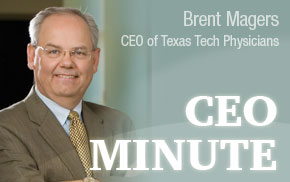 I read an interesting article this weekend by Eugene Fibuch, M.D., chair of the Department
of Anesthesiology, and Arif Ahmed, Ph.D., MSPH, associate professor of health administration,
both of the University of Missouri-Kansas City. The article talks about customer relationship
management (CRM) and using the data gathered from customers to help health care organizations
gain and retain customers. There were some points I thought Texas Tech Physicians
needed to hear given our vision of being a “top-tier medical practice nationally recognized
in quality patient care, satisfaction and value.”
I read an interesting article this weekend by Eugene Fibuch, M.D., chair of the Department
of Anesthesiology, and Arif Ahmed, Ph.D., MSPH, associate professor of health administration,
both of the University of Missouri-Kansas City. The article talks about customer relationship
management (CRM) and using the data gathered from customers to help health care organizations
gain and retain customers. There were some points I thought Texas Tech Physicians
needed to hear given our vision of being a “top-tier medical practice nationally recognized
in quality patient care, satisfaction and value.” CRM is learning all that you can about your customers, communicating with them in a timely and relevant way, tracking the results of your organization’s efforts to satisfy and retain customers, knowing which processes impact the customer and making timely adjustments to those processes. The article said relationship change is driven by information technology, direct communication with the consumer and the changing of quality management tracking and reporting that link the customer directly to the business. Following this logic, once marketing through say, print or television advertising, brings new patients to Texas Tech Physicians, our CRM model will determine whether they return. Our website and patient portal, for example, become very important as they allow us to disburse health information and interact with the patient. The idea is that we are talking directly to our patients, and they are talking directly to us.
We may be competing with numerous ambulatory medical clinics popping up. One of our M.D./MBA students asked me what I thought about the proliferation of such centers, and I said candidly that I wish them all the best, but I believe one or more of them will not make it because so many have opened in close proximity. Whether they do will likely depend upon their own CRM model. Therefore, we should keep what we know about the average consumer in mind as we seek to offer outstanding customer service as well.
Here are some characteristics of today’s consumer we can observe:
· Much more knowledgeable
· Aware he/she has many choices
· Demands value for the health care they receive
These three characteristics fit in nicely with our Key Performance Indicators (KPIs). Our faculty are experts and are willing to share that expertise with patients in person, through social media or take any other opportunity to educate others about their health. This is addressing the consumer’s demand for reliable information or knowledge. Second, we aim to be very accessible to our patients, which I believe makes us stand out among other health care choices.
Finally, we are measuring our patient satisfaction and quality like never before and reporting it to the public via the Web to demonstrate the value of our services. How does one measure quality? That is a good question and debate. For the time, we say that we are measuring it the way the federal government and more than 90 percent of America's health plans measure it, using the Healthcare Effectiveness Data and Information Set, a tool used to measure performance on important dimensions of care and service.
I think we are on the right track, but as Will Rogers said, “Even if you're on the right track, you'll get run over if you just sit there.” Can’t allow that to happen, eh?
